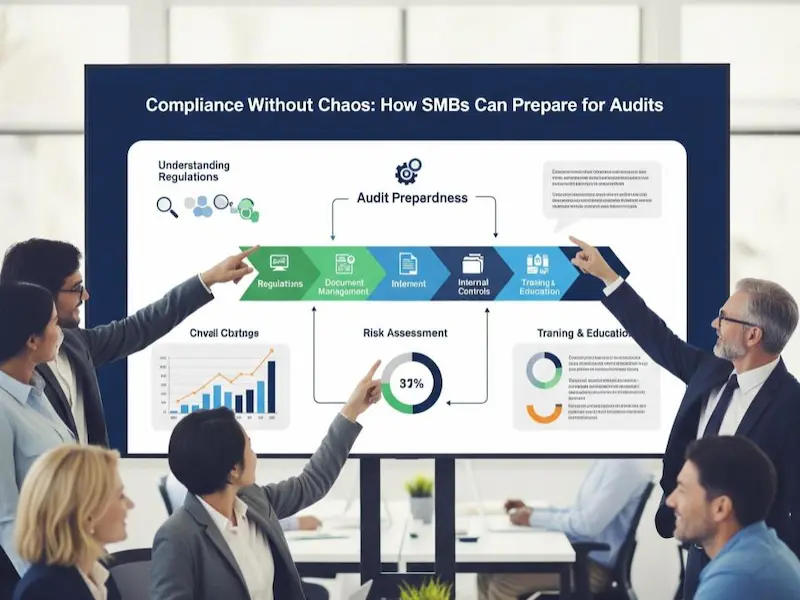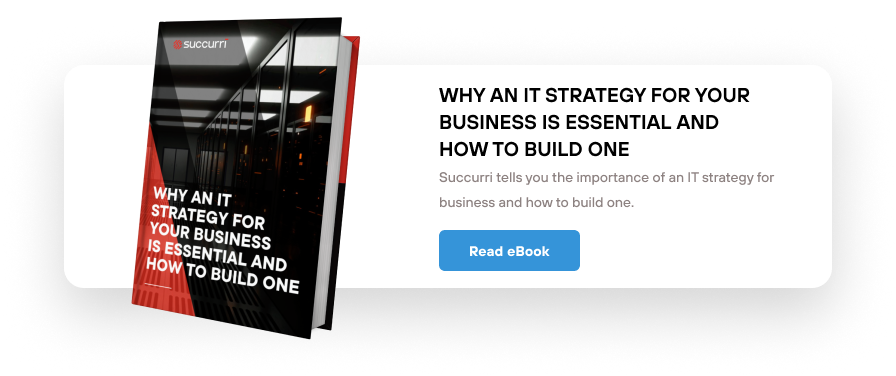Audit Readiness
Audit readiness isn’t a folder of policies; it’s a living system. Build a lightweight control set mapped to your framework (HIPAA, CMMC, PCI DSS, SOC 2, FTC Safeguards), operationalize it with training + technical controls, and keep evidence fresh with a quarterly cadence. Zero Trust principles help eliminate blind spots (especially Shadow IT) and make audits faster, cheaper, and less stressful. Federal Trade Commission+4NIST Computer Security Resource Center+4HHS.gov+4
Who This Guide Is For
Leaders of small to midsize organizations—healthcare groups, builders/contractors, engineering firms, financial services, and tech-enabled SMBs—especially those operating in Seattle/Everett, Phoenix, or Kalispell who need to meet compliance obligations without hiring an army.
Why Compliance Feels Chaotic (and How to Calm It)
- Moving targets: Rules and frameworks evolve (e.g., NIST CSF 2.0 update). Treat your program as iterative, not one-and-done. NIST Computer Security Resource Center
- Shadow IT: Unapproved apps/devices create gaps auditors will notice and attackers exploit.
- Evidence sprawl: Artifacts live across email, SharePoint, ticketing, and people’s desktops.
- People factor: Training and accountability drift without a simple operating rhythm.
Calm the chaos with three pillars: a small-but-complete control set, an evidence calendar, and automation where it helps (IAM/MFA, device compliance, secure file repositories).
The Audit-Readiness Framework (SMB-Sized)
1) Map the Right Frameworks
Pick what actually applies, then cross-map for reuse:
- HIPAA Security Rule (healthcare and BAs) – administrative, physical, and technical safeguards. HHS.gov+1
- CMMC 2.0 (defense supply chain) – protect FCI/CUI through tiered practices and assessments. Acquisition.gov+1
- PCI DSS (card data) – scope reduction + evidence discipline.
- SOC 2 (customer trust) – controls across Security, Availability, Processing Integrity, Confidentiality, Privacy. AICPA & CIMA+1
- FTC Safeguards Rule (financial institutions under FTC) – risk assessment, access controls, monitoring, plus breach reporting (≥500 consumers) within 30 days (effective May 2024). Federal Trade Commission+1
- NIST CSF 2.0 (program backbone) – use as your umbrella risk framework. NIST Computer Security Resource Center
2) Build a Minimal Viable Control Set
Use NIST CSF 2.0 categories to organize controls, then map to HIPAA/CMMC/PCI/SOC 2: Identify → Protect → Detect → Respond → Recover. Keep it lean, measurable, and assignable. NIST Publications
3) Close the Shadow IT Gap
Create an approved app catalog, a fast request pathway, and continuous discovery. Enforce MFA and device compliance, and segment access (least privilege). This both reduces audit findings and supports Zero Trust.
4) Operationalize with a Quarterly Rhythm
- Q1: Risk assessment, policy refresh, access review
- Q2: Training + phishing simulations, vendor due-diligence
- Q3: Incident response tabletop, backup/restore test
- Q4: Internal audit/evidence purge + management review
Repeat annually; adjust by findings.
A 30-60-90 Day Plan (Practical & Doable)
Days 1–30: Baseline & Quick Wins
- Confirm applicable frameworks and scope (systems, data, vendors).
- Deploy MFA everywhere; kill shared accounts; enforce password manager.
- Inventory apps/devices; flag Shadow IT; publish “approved tools” list.
- Stand up a single Evidence Library (e.g., SharePoint or Drive with strict permissions).
Days 31–60: Policies, Training, Vendors
- Refresh plain-English policies (AUP, data handling, incident response, vendor risk, access).
- Launch role-based training + phishing simulation; track completion.
- Triage top vendors: collect SOC 2 / security questionnaires / BAAs / DPAs.
Days 61–90: Drill & Dress Rehearsal
- Run an incident response tabletop and a backup/restore test; document outcomes.
Conduct an internal mini-audit against a controls checklist; log corrective actions. - Close access review findings (joiners/movers/leavers) and Shadow IT gaps.
Your Pre-Audit Checklist
- Governance: Roles/RACI, management review minutes, risk assessment
- Policies: AUP, access control, encryption, data retention, vendor risk, IR plan, BCP/DR
- Identity & Access: MFA evidence, least-privilege attestations, quarterly access review
- Asset & Change: Device inventory, secure configurations, patching cadence, change logs
- Data Protection: Encryption at rest/in transit, backup schedules, restore tests
- Monitoring & Response: SIEM/alerts evidence, incident logs, tabletop artifacts
- Training: Completion logs, phishing metrics, remediation records
- Vendors: Contracts/BAAs/DPAs, SOC 2s, risk ratings, remediation follow-ups
- Evidence Library: Dated, versioned artifacts mapped to specific requirements
“Audits become easy when your controls are real and your evidence is fresh. The goal isn’t to ‘pass the test’—it’s to run a resilient, low-friction security program every quarter.”
— Grant Eckstrom, vCISO, Succurri
Common Pitfalls (And How to Avoid Them)
- Policy theater: Documents no one uses. Fix with short, role-based policies and onboarding refreshers.
- Unowned controls: Every control needs a named owner and a due date.
- Evidence everywhere: Centralize artifacts by requirement with a simple index.
- Shadow IT creep: Continuous discovery + approved alternatives + clear comms.
- Vendor blind spots: Treat vendors like extensions of your environment—collect proofs and track issues.
- No muscle memory: Tabletop at least annually; practice beats paperwork.

Zero Trust Makes Audits (and Breaches) Less Painful
Zero Trust—verify explicitly, enforce least privilege, assume breach—shrinks scope, improves logs, and eliminates “invisible” access paths auditors hate. Mapping Zero Trust controls to NIST CSF 2.0 provides a common language for leadership and auditors alike. NIST Computer Security Resource Center
Local Audit Readiness for Businesses Near Seattle Everett, Phoenix, Kalispell
Seattle & Everett (PNW): Hybrid/field teams, project data, and vendor collaboration increase risk. We align your NIST-backed control set to real workflows and Washington-specific expectations.
Phoenix (AZ): Healthcare and financial services face HIPAA/PCI + FTC Safeguards scrutiny. We tighten identity, third-party risk, and breach-notification readiness. Federal Trade Commission+1
Kalispell (MT): Lean IT? No problem. We right-size your program—fewer tools, clearer policies, disciplined evidence—so audits don’t swamp the team.
How Succurri Helps (Fast, Measurable, Auditor-Friendly)
- vCISO leadership to pick frameworks, set scope, and own the calendar
- Control mapping (NIST CSF 2.0 backbone) + minimal viable policies NIST Computer Security Resource Center
- Identity hardening: MFA, least-privilege, access reviews
- Shadow IT reduction: approved app catalog + monitoring
- Evidence Library build-out: templates, tags, quarterly refresh
- Drills & tests: incident tabletop, backup/restore, corrective actions
Audit support: pre-read, evidence packaging, auditor Q&A
Frequently Asked Questions (FAQs)
Do we need SOC 2 if we’re not a SaaS?
Not always. But its Trust Services Criteria can shape a strong control set even if you don’t pursue a formal report. AICPA & CIMA+1
Is NIST CSF 2.0 required?
No—widely recommended and increasingly referenced. It’s an excellent backbone for SMBs. NIST Computer Security Resource Center
What about FTC Safeguards—are we covered?
If you fall under FTC’s definition of a financial institution, yes—there are prescriptive elements and a breach-notification rule (30 days, ≥500 consumers). Federal Trade Commission+1
CMMC timelines?
Requirements are evolving; align early to protect FCI/CUI and reduce contract risk. Acquisition.gov+1
Schedule an Audit Readiness Assessment
Want compliance without chaos? Let’s build a lean, auditable program that actually improves security—and doesn’t hijack your day job.
Schedule an Audit Readiness Assessment with Succurri’s vCISO team in Seattle, Everett, Phoenix, or Kalispell.
About the Author – Grant Eckstrom, vCISO
Grant leads Succurri’s vCISO practice, helping SMBs operationalize compliance (HIPAA, CMMC, PCI DSS, SOC 2, FTC Safeguards) with NIST CSF 2.0 and Zero Trust. He’s known for practical roadmaps, strong vendor-risk governance, and audit packs that pass muster—without the chaos.





